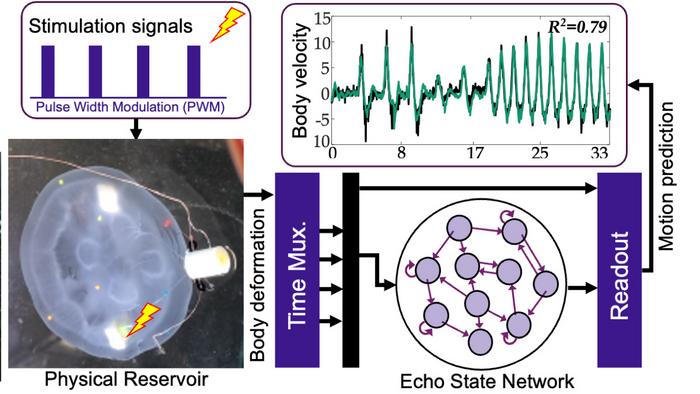In a groundbreaking fusion of biology and artificial intelligence, scientists have unveiled a novel approach to underwater exploration by transforming jellyfish into cyborg swimmers. These hybrid creatures, powered not by conventional engines but by their own natural muscular rhythms, represent a new frontier in sustainable oceanographic research. The innovative study, spearheaded by a multidisciplinary team at Tohoku University and published in Nature Communications, showcases how softly-bodied marine animals can be integrated with simple computational systems to produce efficient, low-energy aquatic probes.
Unlike fish, jellyfish navigate the aquatic realm without a skeletal framework or a complex nervous system. A jellyfish’s propulsion mechanism hinges on a muscular ring within its gelatinous bell, generating pulsed jets that push it through the water with remarkable efficiency. This innate capability, referred to by scientists as "embodied intelligence," embodies the principle that an organism’s physical structure itself can mediate problem-solving behaviors. By tapping into this phenomenon, researchers sought to harness and modulate the jellyfish’s locomotion patterns, steering these creatures with gentle electrical stimuli.
The research team developed a method to apply miniature electrodes directly onto the jellyfish’s muscle ring, delivering timed electric pulses that influence its propulsion. Crucially, the pulse sequences were designed to synchronize with the jellyfish’s intrinsic swimming rhythm rather than override it, thereby preserving the animal’s natural movement and minimizing stress. By aligning artificial inputs with biological processes, the jellyfish cyborgs respond predictably to external control signals, accelerating or modulating their swimming speeds as intended.
Recording each pulsing motion presented its own challenges, met by an innovative three-dimensional video capture system. Utilizing a single camera paired with two mirrors, the team reconstructed the jellyfish’s spatial trajectories with precision. This comprehensive dataset provided the foundation to train an AI model capable of forecasting the “next move” in the jellyfish’s locomotion, transforming the organism’s body into an integral component of a hybrid computational system.
The AI framework employed is a lightweight hybrid reservoir computing model. Reservoir computing is a neural network paradigm well-suited for processing temporal sequences and dynamic systems. What distinguishes this approach is its physical implementation: the jellyfish’s own biomechanical properties act as part of the “reservoir,” leveraging inherent system dynamics for computation. This reduces the need for heavy onboard processing hardware, allowing the cyborg jellyfish to maintain a minimal power footprint.
One of the most striking findings of the study was the importance of natural rhythm in pulse control. Contrary to initial assumptions that faster or stronger electric pulses would yield superior swimming performance, it was the pulses that harmonized with the animal’s baseline pulsation pattern that enhanced locomotion efficiency. Excessively rapid or potent stimuli disrupted the jellyfish’s coordination, leading to unstable movements and diminished propulsion. This revelation underscores a crucial design lesson for biohybrid robotics: working in concert with nature’s rhythms can yield sustainable control strategies that respect biological integrity.
The implications of this research reach far beyond the laboratory. The jellyfish cyborgs operate without engines or batteries, drastically reducing ecological disturbance compared to traditional ocean monitoring devices. These living robots could be deployed in vast numbers to map coral reefs, track pollutants like oil spills, or monitor oceanographic parameters such as temperature and salinity over extended periods. Their soft bodies and gentle propulsion minimize the risk of damage to fragile marine ecosystems, allowing for a new class of environmentally conscious scientific instrumentation.
Furthermore, this study opens avenues in soft robotics, where mimicry of flexible, self-healing, and adaptable organisms could revolutionize machine design. Soft-bodied robots inspired by jellyfish could navigate constrained or delicate environments where rigid machines falter. Beyond oceanography, such biologically integrated systems could have applications in medicine, environmental monitoring, and exploration.
The collaborative nature of this research brought together expertise from robotics, mechano-informatics, and marine biology. Researchers from Tohoku University’s Department of Robotics partnered with colleagues at The University of Tokyo’s Graduate School of Information Science and Technology, as well as practitioners from Kamo Aquarium, ensuring a comprehensive approach from biological insight to technological innovation.
Technically, the system’s ability to predict swimming speed and direction relied on capturing subtle biomechanical cues through the reservoir computing model. Incorporating the jellyfish’s physical body into the computational framework leverages dynamics that standard AI models might overlook. This embodiment of intelligence suggests a shift in how future biohybrid and robotic systems could be designed — blending living structures with electronic control to achieve computational and mechanical capabilities unattainable by either alone.
Another exciting potential is the scalability of this approach. Jellyfish, as soft-bodied, energy-efficient swimmers, present a uniquely suitable platform for such cybernetic augmentation. Their biology naturally lends itself to integration with electronic control systems, making them ideal candidates for future exploration fleets. These networks of autonomous cyborg jellyfish could relay real-time environmental data, providing scientists with unprecedented coverage and resolution of marine conditions.
Moving forward, the team’s focus will likely include refining electrode designs, improving AI prediction models, and developing non-invasive techniques to further minimize any impact on the jellyfish. Ethical considerations will also play a crucial role in deploying these systems widely, ensuring the welfare of these living components and their ocean habitats.
In sum, this pioneering research represents a marriage of natural and artificial intelligence, crafting a new paradigm in environmental science and robotics. By harnessing the subtle dance between biology and technology, scientists have taken a vital step toward creating low-impact, intelligent machines that glide through the world’s oceans not as invaders, but as harmonious partners.
Subject of Research: Integration of jellyfish locomotion with artificial intelligence to create low-energy, biologically harmonious cyborg swimmers for oceanographic applications.
Article Title: Harnessing Natural Embodied Intelligence for Spontaneous Jellyfish Cyborgs
News Publication Date: 23-May-2025
Web References:
DOI: 10.1038/s41467-025-59889-7
Image Credits: Credit: Dai Owaki
Keywords: Marine biology, Robotic locomotion




